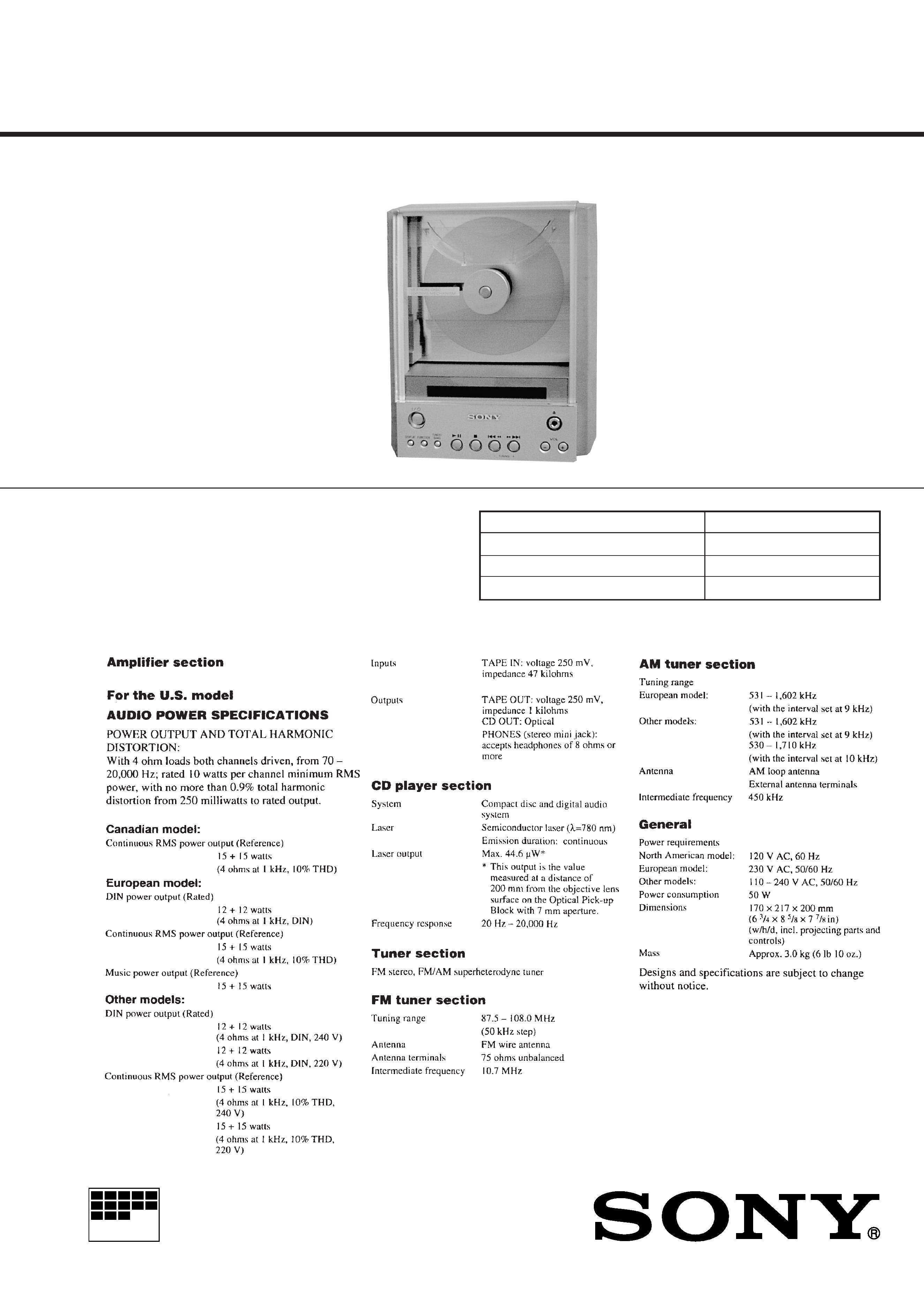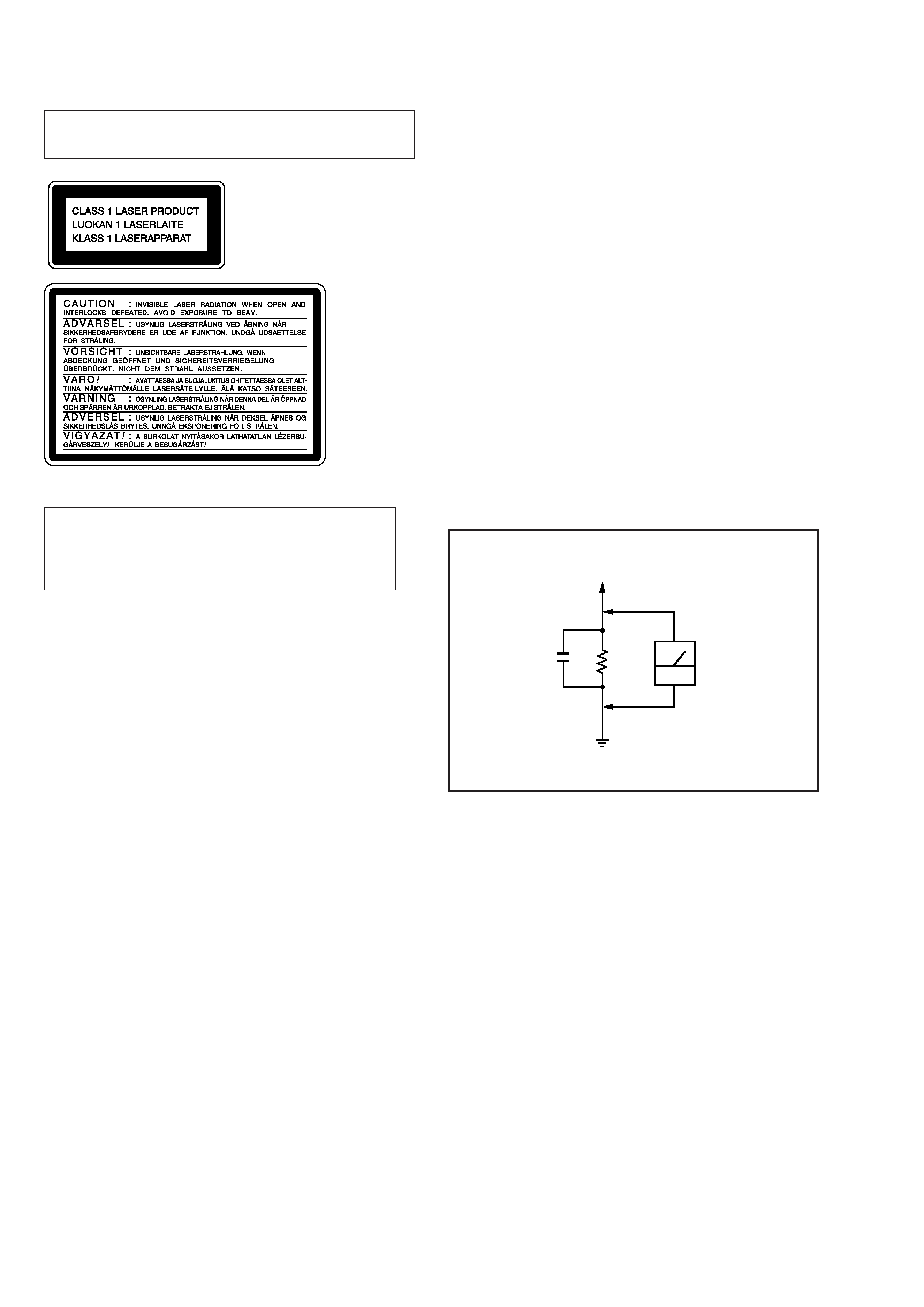
COMPONENT MODEL NAME FOR CMT-EX1
COMPACT DISC DECK RECEIVER SYSTEM
HCD-EX1
SPEAKER SYSTEM
SS-CEX1
CMT-EX1
US Model
Canadian Model
AEP Model
UK Model
E Model
Australian Model
Tourist Model
SERVICE MANUAL
General
Power requirements
North American model:
120 V AC, 60 Hz
European model:
230 V AC, 50/60 Hz
Other models:
110 - 240 V AC, 50/60 Hz
Power consumption
40W
ACCESSORIES & PACKING MATERIALS
*******************************
1-418-614-11 COMMANDER, STANDARD (RM-SCEX1)
1-754-121-11 ANTENNA, LOOP
1-754-112-11 ANTENNA (FM) (EXCEPT US,CND)
1-754-113-11 ANTENNA (FM) (US,CND)
1-792-139-11 CORD, SPEAKER (1m)
3-867-450-11 MANUAL, INSTRUCTION (ENGLISH)
3-867-450-21 MANUAL, INSTRUCTION (FRENCH) (US,CND)
3-867-450-31 MANUAL, INSTRUCTION (FRENCH,SPANISH)
(AEP,E,MY,SP,AR)
3-867-450-41 MANUAL, INSTRUCTION (GERMAN,DUTCH,
PORTUGUESE,ITALIAN) (AEP)
3-867-450-51 MANUAL, INSTRUCTION (DANISH,FINNISH,
SWEDISH) (AEP)
3-867-450-61 MANUAL, INSTRUCTION (CHINESE) (SP,MY,HK)
4-993-348-01 COVER, BATTERY (FOR RM-SCEX1)
4-225-981-01 FOOT A (FOR SS-CEX1)
PARTS LIST
COMPACT COMPONENT SYSTEM
· CMT-EX1 is composed of following models.
As for the service manual, it is issued for each component
model, then, please refer to it.
·Abbreviation
CND : Canadian model
AR : Argentine model
MY : Malaysia model
AUS : Australian model
SP
: Singapore model
JE
: Tourist model
HK : Hong Kong model
KR : Korea model
Supplied accessories
Remote Commander (1)
Batteries (2)
AM loop antenna (1)
FM wire antenna (1)
Speaker cords (2)
Speaker legs (4)
Design and specifications are subject to change without notice.
Ref. No. Part No.
Description
Remark
SPECIFICATIONS
Ver 1.1 2001. 05
9-929-015-12
2001E0200-1
© 2001.5
Sony Corporation
Personal Audio Company
Shinagawa Tec Service Manual Production Group

CMT-EX1
REVISION HISTORY
Clicking the version allows you to jump to the revised page.
Also, clicking the version at the upper right on the revised page allows you to jump to the next revised
page.
Ver.
Date
Description of Revision
1.1
2001.05
Addition and correction of accessories.
(SFD-00004)
1.0
1999.08
New

1
HCD-EX1
US Model
Canadian Model
AEP Model
UK Model
E Model
Australian Model
Tourist Model
COMPACT COMPONENT SYSTEM
MICROFILM
SERVICE MANUAL
SPECIFICATIONS
Model Name Using Similar Mechanism NEW
Mechanism Type
CDM-60
Base Unit Type
KSM-770ACA/S-NP
Optical Pick-up Type
KSS-770A/S-N1
HCD-EX1 is the amplifier, CD and
tuner section in CMT-EX1.

2
SAFETY CHECK-OUT
After correcting the original service problem, perform the follow-
ing safety checks before releasing the set to the customer:
Check the antenna terminals, metal trim, "metallized" knobs, screws,
and all other exposed metal parts for AC leakage. Check leakage as
described below.
LEAKAGE
The AC leakage from any exposed metal part to earth Ground and
from all exposed metal parts to any exposed metal part having a
return to chassis, must not exceed 0.5 mA (500 microampers). Leak-
age current can be measured by any one of three methods.
1. A commercial leakage tester, such as the Simpson 229 or RCA
WT-540A. Follow the manufacturers' instructions to use these
instruments.
2. A battery-operated AC milliammeter. The Data Precision 245
digital multimeter is suitable for this job.
3. Measuring the voltage drop across a resistor by means of a VOM
or battery-operated AC voltmeter. The "limit" indication is 0.75
V, so analog meters must have an accurate low-voltage scale.
The Simpson 250 and Sanwa SH-63Trd are examples of a pas-
sive VOM that is suitable. Nearly all battery operated digital
multimeters that have a 2V AC range are suitable. (See Fig. A)
Fig. A. Using an AC voltmeter to check AC leakage.
0.15
µF
To Exposed Metal
Parts on Set
1.5k
AC
voltmeter
(0.75V)
Earth Ground
SAFETY-RELATED COMPONENT WARNING !!
COMPONENTS IDENTIFIED BY MARK
! OR DOTTED LINE
WITH MARK
! ON THE SCHEMATIC DIAGRAMS AND IN
THE PARTS LIST ARE CRITICAL TO SAFE OPERATION.
REPLACE THESE COMPONENTS WITH SONY PARTS
WHOSE PART NUMBERS APPEAR AS SHOWN IN THIS
MANUAL OR IN SUPPLEMENTS PUBLISHED BY SONY.
CAUTION
Use of controls or adjustments or performance of procedures
other than those specified herein may result in hazardous ra-
diation exposure.
Notes on chip component replacement
· Never reuse a disconnected chip component.
· Notice that the minus side of a tantalum capacitor may be
damaged by heat.
Flexible Circuit Board Repairing
· Keep the temperature of soldering iron around 270°C
during repairing.
· Do not touch the soldering iron on the same conductor of the
circuit board (within 3 times).
· Be careful not to apply force on the conductor when soldering
or unsoldering.
Laser component in this product is capable of emitting radiation
exceeding the limit for Class 1.
This appliance is classified as
a CLASS 1 LASER product.
The CLASS 1 LASER PROD-
UCT MARKING is located on
the rear exterior.
This caution
label is located
inside the unit.
ATTENTION AU COMPOSANT AYANT RAPPORT
À LA SÉCURITÉ!!
LES COMPOSANTS IDENTIFIÉS PAR UNE MARQUE
!SUR
LES DIAGRAMMES SCHÉMATIQUES ET LA LISTE DES
PIÈCES SONT CRITIQUES POUR LA SÉCURITÉ DE
FONCTIONNEMENT. NE REMPLACER CES COMPOSANTS
QUE PAR DES PIÈCES SONY DONT LES NUMÉROS
SONT DONNÉS DANS CE MANUEL OU DANS LES
SUPPLÉMENTS PUBLIÉS PAR SONY.

3
NOTES ON HANDLING THE OPTICAL PICK-UP BLOCK
OR BASE UNIT
The laser diode in the optical pick-up block may suffer electrostatic
break-down because of the potential difference generated by the
charged electrostatic load, etc. on clothing and the human body.
During repair, pay attention to electrostatic break-down and also
use the procedure in the printed matter which is included in the
repair parts.
The flexible board is easily damaged and should be handled with
care.
NOTES ON LASER DIODE EMISSION CHECK
The laser beam on this model is concentrated so as to be focused on
the disc reflective surface by the objective lens in the optical pick-
up block. Therefore, when checking the laser diode emission, ob-
serve from more than 30 cm away from the objective lens.
LASER DIODE AND FOCUS SEARCH OPERATION
CHECK
Carry out the "S curve check" in "CD section adjustment" and check
that the S curve waveform is output four times.
TABLE OF CONTENTS
1. SERVICING NOTE .......................................................... 4
2. GENERAL .......................................................................... 7
3. DISASSEMBLY
3-1. Back Cover and Case ............................................................ 9
3-2. Panel Board and Stabilizer .................................................... 9
3-3. AMP Block ......................................................................... 10
3-4. CD Block ............................................................................ 10
3-5. Motor ASSY and CAM ....................................................... 11
3-6. Base Unit ............................................................................. 11
3-7. Main Board and Power Board ............................................ 12
4. ELECTRICAL ADJUSTMENT .............................. 13
5. DIAGRAMS
5-1. Circuit Boards Location ...................................................... 14
5-2. Printed Wiring Board Main Section .............................. 16
5-3. Schematic Diagram Main (1/3) Section ........................ 18
5-4. Schematic Diagram Main (2/3) Section ........................ 19
5-5. Schematic Diagram Main (3/3) Section ........................ 20
5-6. Printed Wiring Board LED/Loading/SW Section ......... 21
5-7. Schematic Diagram
LED/Loading/SW Section Section ............................... 21
5-8. Printed Wiring Board AMP Section .............................. 22
5-9. Schematic Diagram AMP Section ................................. 23
5-10. Printed Wiring Board Panel Section ........................... 24
5-11. Schematic Diagram Panel Section ............................. 25
5-12. Printed Wiring Board Power Section ......................... 26
5-13. Printed Wiring Board Power Section ......................... 27
5-14. Printed Wiring Board REG Section ............................ 28
5-15. Schematic Diagram REG Section .............................. 29
5-16. IC Block Diagrams ........................................................... 30
5-17. IC Pin Functions ............................................................... 32
6. EXPLODED VIEWS
6-1. Front and Case Section ....................................................... 36
6-2. Chassis Section ................................................................... 37
6-3. Mechanism Section ............................................................. 38
6-4. Base Unit Section ................................................................ 39
7. ELECTRICAL PARTS LIST
................................. 40
